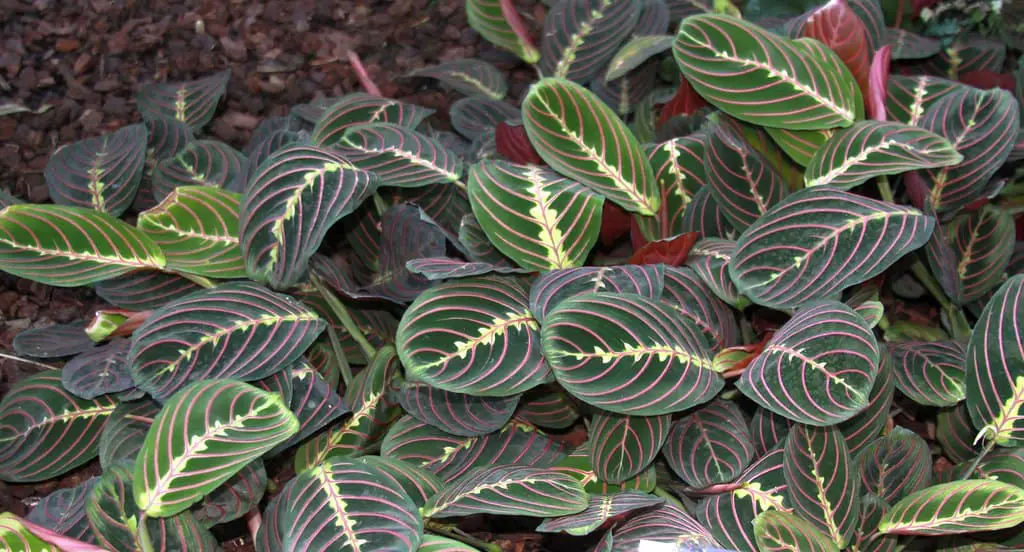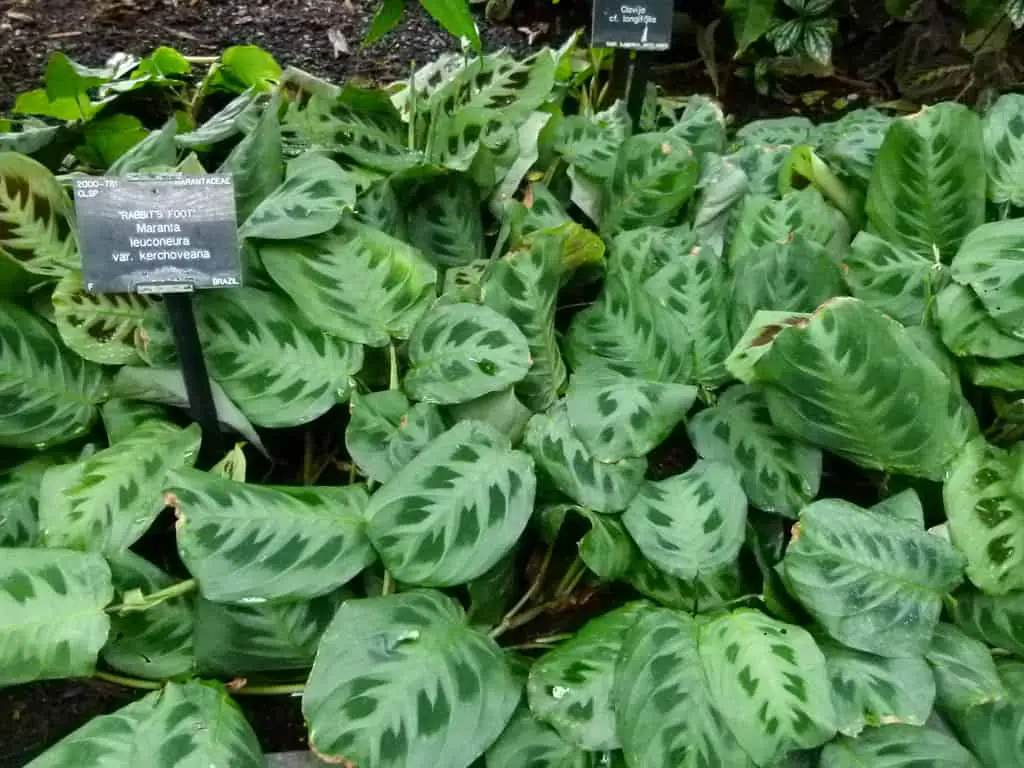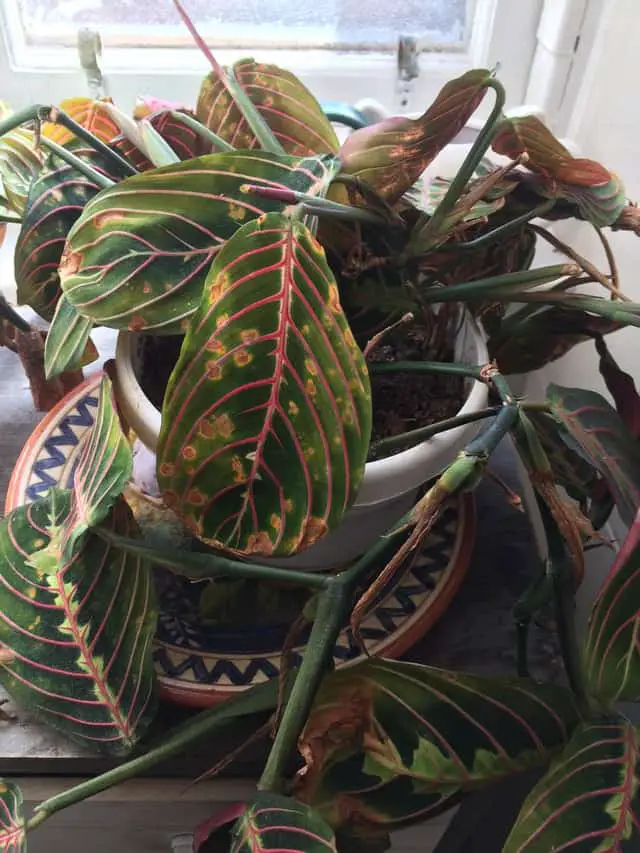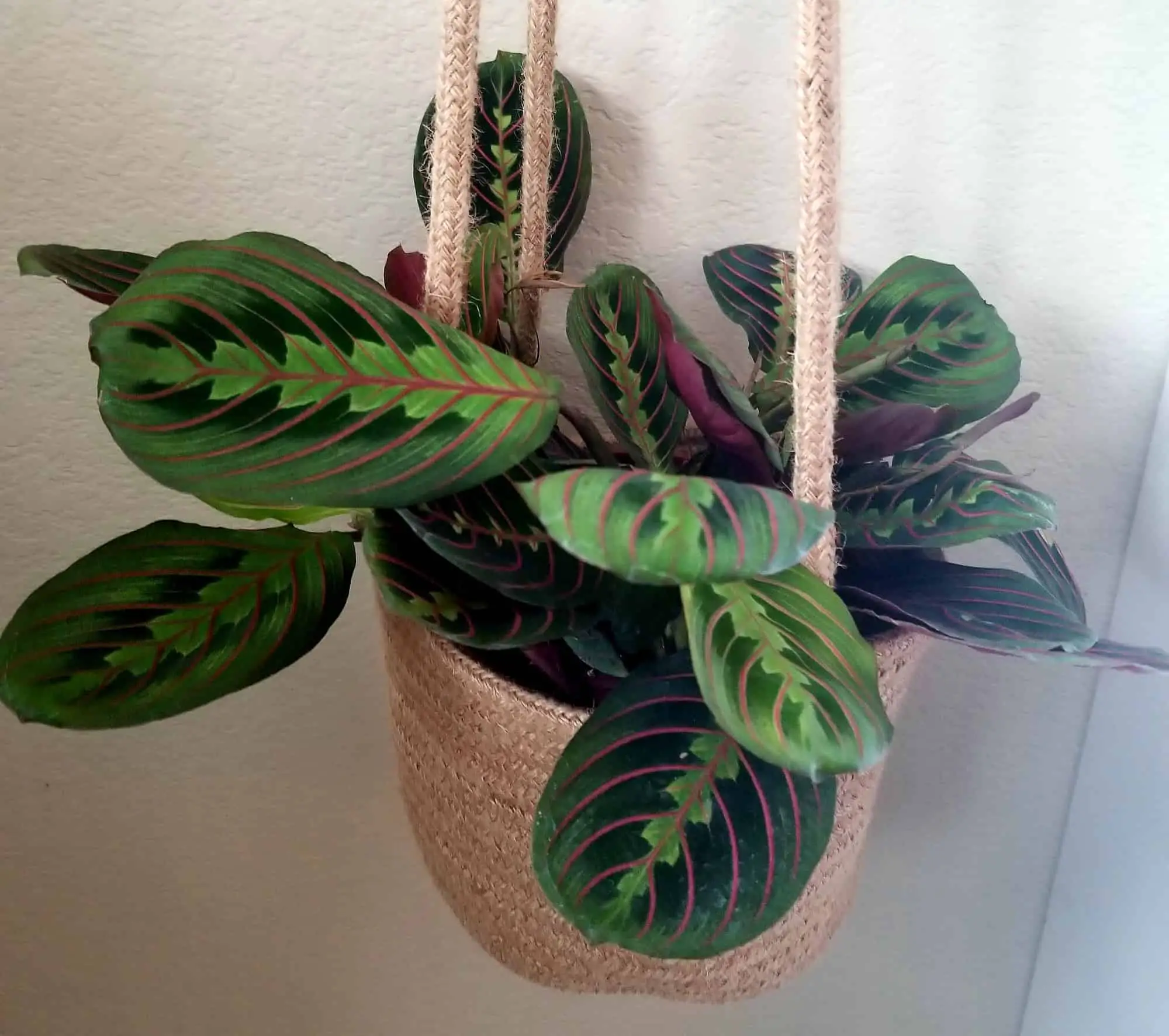Maranta leuconeura, which is commonly known Prayer Plant, Cathedral Windows, Herringbone Plant, and Rabbit Tracks is a popular houseplant. They are commonly kept as houseplants because of their stunningly beautiful foliage. However, they do produce tiny, delicate flowers when grown in ideal conditions.
Although Prayer Plants are considered hardy houseplants, they are not the kind of plant you can neglect for weeks and expect to thrive. Their soil should be evenly moist all of the time, and they should be placed in an area that is exposed to indirect sunlight. A spot that is 5-10 feet from a window that receives direct sunlight works well.
This article will provide you with the information you need to keep your Prayer Plant happy so you can enjoy it for years to come!
About Prayer Plant
Maranta leuconeura, commonly known as Prayer Plant is a species within the Marantaceae family. Within the Marantaceae family, it is a part of the Maranta genus. This genus is named for Bartolomeo Maranta, an Italian botanist and physician during the 16th century.
Prayer Plant is a low-growing plant that is native to the tropical forests of Brazil. It is well known for its stunningly beautiful leaves.
This plant is called Prayer Plant because they close their leaves at night as if they are in prayer. This response to sunlight and darkness is called nyctinasty. The video below shows how Prayer Plant moves throughout a 24-hour period.
These plants will also live a long time. If you care for these plants properly, they can live up to 40 years!
Varieties
“Prayer Plant” is a generic term for the 40 species of plants that belong to the Marantacea family. However, Maranta leuconeura is the species most commonly kept as a houseplant. There are a few varieties of Maranta leuconeura as shown below.
Maranta leuconeura ‘leuconeura’ (Black Prayer Plant)

Maranta leuconeura ‘erythroneura’ (Red Prayer Plant)

Maranta leuconeura ‘Kerchoveana’ (Green Prayer Plant)

Maranta leuconeura ‘Marisela’

Light
Prayer Plant will grow best when it is exposed to 4-6 hours of indirect light each day. Ideally, you should put your Prayer Plant in a spot that is 5-10 feet from a window that receives a lot of sunlight. These plants definitely do not belong on a window sill. Avoid putting your Prayer Plant in an area that is exposed to hot, direct sunlight. Too much light will cause the leaves’ colors to fade. Curling leaves is another sign that your Prayer Plant may be getting too much light.
Prayer Plant can tolerate darker conditions. If your Prayer Plant is not receiving enough sunlight, you will start to notice that the leaves will close at night and not fully open during the day.
Cleaning Plant Leaves
Finally, it is important to clean the leaves of your Prayer Plant to ensure that it is able to absorb light properly in order to photosynthesize. If you do not clean your plants’ leaves regularly, a layer of dust will accumulate on the leaves over time. This dust layer will block sunlight and hinder the plant’s ability to photosynthesize and make food for itself.
To clean your Prayer Plant’s leaves, gently wipe the leaves with a damp, wet cloth. I do not recommend rinsing the leaves off in the sink or with a hose. This is because allowing the leaves to get wet can make the plant vulnerable to Helminthosporium Leaf Spot which is a disease caused by a group of fungi Bipolaris, Drechslera, and Exserohilum spp) that is active over a wide range of temperatures.
Watering
The soil that your Prayer Plant is growing in should be kept evenly moist, but not drenched or soggy, all of the time. Unlike many other types of plants, you should not allow the soil completely dry between watering sessions. In other words, the “soak and dry” method is not a good watering strategy for Prayer Plant. It is better to give this plant a little water more frequently.
Prayer Plant is also sensitive to the chlorine and fluoride content of tap water. You can remove chlorine from tap water by letting it sit out in an a bucket of water for 8-12 hours. Unfortunately, it is more difficult to remove fluoride from water. For this reason, it is best to water your Prayer Plant with filtered water or rainwater.
These plants are also sensitive to the mineral content of water. If you own a water softener, make sure you are using water from a spigot that is not connected to the softener to water your plants.
Soil
This plant will do well in a high-quality potting soil as long as that soil provides good drainage. To improve drainage, consider adding perlite or coarse sand to the potting soil.
Fertilizer
Prayer Plants grow vigorously and benefit from fertilizing during the growing season (early spring through fall). Depending on the size of your plant, fertilize every two to four weeks with 10-10-10 fertilizer diluted to half strength. Although your plant will grow more slowly if you underfertilize, it is best to fertilize less frequently when in doubt. Applying too much fertilizer can burn the plant roots and even kill your plant.
Temperature and Humidity
Because Prayer Plant is native to a tropical climate, it prefers warm, humid environments. These plants will do in temperatures between 60°F and 80°F. However, temperatures below 55°F can damage the leaves. Hot, intense sunlight can also damage the leaves.
Like many plants, it is important to avoid placing your Prayer Plant near fireplaces, heating vents, drafty windows, or air conditioning units because excessive temperature fluctuations are not good for Prayer Plants.
Brown tips and curling leaves are signs that your Prayer Plant needs more humidity. To increase the humidity, place your Prayer Plant next to other houseplants. You could also purchase a plant humidifier or use a pebble tray filled with water.
Avoid misting these plants to increase the humidity. Unfortunately, these plants are particularly susceptible to fungal diseases, so misting tends to do more harm than good.
Pruning
Pruning your prayer plant will encourage the plant to grow “bushier” rather than taller or longer. To prune your Prayer Plant, use sterilized scissors to avoid infecting your plant with any diseases. Then remove the stems above leaf nodes. This will encourage the plant to produce new shoots right below the cut, resulting in a bushier appearance.
Finding leaf nodes on a Prayer Plant is a bit less intuitive than other plants. This video shows you how to find a leaf node and where to cut when pruning.
Pests and Diseases
Unfortunately, Prayer Plant is susceptible to some pest and disease problems. In general, it is best to isolate any plants with pest problems in order to minimize the chance of spreading infections to other plants.
Helminthosporium Leaf Spot
As previously discussed, Helminthosporium Leaf Spot is a fungal disease. It is typically caused by overwatering. Leaf spots typically look like brown/tan spots with a yellow halo. If you determine that your plant has fungal leaf spots, apply fungicide and water your plant less frequently.

Photo Credits: Reddit User Brobie
Spider Mites
Spider mites are a common pest that attack many types of plants, and they are the most common pest problem for Prayer Plant owners. These bugs attack the bottom parts of leaves and are attracted to warm, dry environments. Because they are drawn to drier environments, spider mites tend to be a bigger problem during the winter months.
To treat a spider mite infestation, spray the leaves of the plant with an insecticidal soap or a mixture of soap and water. Make sure you spray the plant thoroughly so you kill all of the spider mites. Repeat this process every 4-7 days until the spider mites are gone.
The key to getting rid of spider mites is NOT what you use but how you apply it. Make sure your spray makes contact with every spider mite. These little creatures can easily avoid droplets. The survivors will continue to reproduce and infect the plant.
Mealybugs
Mealybugs are another common houseplant pest. Mealybugs are a group of about 275 species that are soft-bodied, wingless insects that look like white splotches of cotton. Mealybugs damage plants by sucking the sap from the plant tissues. This causes the leaves to yellow and/or curl.
To treat a mealybug infestation, apply neem oil or systemic pesticide. In addition, you can use a cotton swab to apply rubbing alcohol directly to the mealybugs. Do not forget to check the pot and saucer for mealybugs.

Photo Credits: Reddit User TheMotBuchanan
Propagating Prayer Plant
Propagation is the process of cloning or multiplying plants. Learning how to propagate your houseplants can allow you to “make” more plants for free. Many plant lovers propagate plants for plant swaps or to give away as gifts.
Stem Cuttings
Like many plants, you can propagate Prayer Plant with stem cuttings. Simply cut a section of Prayer Plant below a leaf node (refer to the video in the pruning section of this article). Then dip the cutting in rooting hormone (optional), and place the cutting in a vase full of water. As previously discussed, Prayer Plant is sensitive to some of the chemicals typically found in tap water, so make sure to put your cuttings in filtered water. After several weeks, roots will begin to form at the end of the cutting. Once the roots have formed, plant the cutting in a shallow pot with fresh soil.
Propagation By Division
Prayer Plants spread via rhizomes, which are underground stems that send out roots and shoots. This means that you can divide your prayer plant during repotting. Simply use a sharp knife to cut between clusters of plant as shown in the image below. Then plant the divisions in fresh, well-draining soil.

Is Prayer Plant Toxic to Pets?
According to the American Society for the Prevention of Cruelty to Animals (ASPCA), Prayer Plant is non-toxic to dogs, cats, and horses. In addition, Prayer Plant is on the Minnesota Poison Control System’s list of non-toxic plants.
It is important to remember that although Prayer Plant is non-toxic, it can still cause undesirable reactions (e.g., choking) if ingested. For this reason, it is best to put houseplants in locations that are not accessible to pets or small children.

